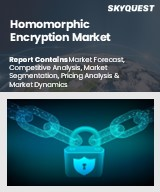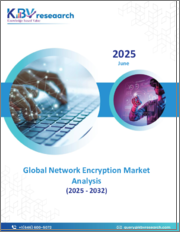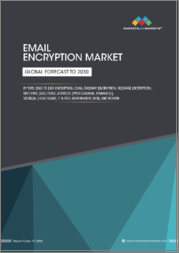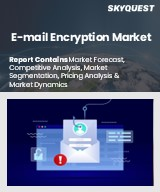
|
시장보고서
상품코드
1574295
세계의 데이터베이스 암호화 시장 : 데이터베이스 유형, 방식, 전개 유형, 조직 규모, 최종 사용자 산업, 컴포넌트, 기능별 예측(2025-2030년)Database Encryption Market by Database Type, Method, Deployment Type, Organization Size, End-User Industry, Component, Functionality - Global Forecast 2025-2030 |
||||||
데이터베이스 암호화 시장의 2023년 시장 규모는 76억 3,000만 달러로 평가되었고, 2024년에는 86억 2,000만 달러에 이를 것으로 예측되며, 복합 연간 성장률(CAGR) 10.57%로 성장할 전망입니다. 2030년에는 154억 3,000만 달러에 달할 것으로 예상됩니다.
데이터베이스 암호화는 기밀성을 보장하고 무단 액세스를 방지하기 위해 정지 및 전송 중 데이터를 보호하는 것을 포함합니다. 그 범위는 금융, 헬스케어, 정부기관 등 기밀정보의 보호가 최우선인 다양한 산업에 걸칩니다. 데이터베이스 암호화의 필요성은 사이버 위협 증가, 규제 준수 요구(GDPR(EU 개인정보보호규정), HIPAA 등), 디지털 데이터의 급속한 보급으로 점점 높아지고 있습니다. 따라서 데이터베이스를 침해로부터 보호하고 데이터 무결성과 프라이버시를 보장하기 위해 이 용도는 매우 중요합니다. 최종 용도의 주요 범위는 IT 및 통신, 은행/금융서비스/보험(BFSI), 헬스케어, 소매, 에너지 분야 등입니다.
| 주요 시장 통계 | |
|---|---|
| 기준년(2023) | 76억 3,000만 달러 |
| 예측년(2024) | 86억 2,000만 달러 |
| 예측년(2030) | 154억 3,000만 달러 |
| 복합 연간 성장률(CAGR)(%) | 10.57% |
데이터베이스 암호화 시장의 성장은 사이버 공격의 빈도와 세련도 상승, 기업 전체의 디지털 변혁의 급증, 엄격한 데이터 보호 대책을 의무화하는 규제 틀의 강화 등 몇 가지 중요한 요인의 영향을 받고 있습니다. 최근 클라우드 컴퓨팅의 진보와 SaaS(Software as a Service)의 채용 증가는 클라우드 환경에 데이터베이스 보호를 위한 강력한 암호화 프로토콜을 통합함으로써 잠재적인 비즈니스 기회를 가져오고 있습니다. 기업은 확장 가능하고 비용 효율적인 암호화 솔루션을 개발하고 인공지능과 머신러닝에 투자하여 암호화 효율성과 대응 능력을 높여 이러한 기회를 활용할 수 있습니다.
그러나, 이 시장은 도입 비용 증가, 암호화 오버헤드로 인한 시스템 성능에 미치는 잠재적인 영향, 암호화 키 관리의 복잡성 등의 과제에 직면하고 있습니다. 또한 고급 암호화 방식을 관리할 수 있는 숙련자의 부족도 한계 중 하나입니다. 이러한 문제를 해결하려면 경량 암호화 알고리즘, 키 관리 솔루션, IT 보안 담당자를 위한 교육 프로그램 등의 분야에서 기술 혁신이 필요합니다. 호모모픽 암호 및 양자 컴퓨팅과 같은 새로운 기술은 연구 개발의 새로운 길을 제공하고 혁신을 더욱 촉진할 수 있습니다. 전반적으로 데이터베이스 암호화 시장은 견고한 확장 태세에 있지만 진화하는 보안 위협과 기술 환경에 적응하기 위해서는 지속적인 발전이 필요합니다.
시장 역학 : 빠르게 진화하는 데이터베이스 암호화 시장의 주요 시장 인사이트 공개
데이터베이스 암호화 시장은 수요 및 공급의 역동적 인 상호 작용에 의해 변모하고 있습니다. 이러한 시장 역학의 진화를 이해함으로써 기업은 충분한 정보를 바탕으로 투자결정, 전략적 결정 정밀화, 새로운 비즈니스 기회 획득에 대비할 수 있습니다. 이러한 동향을 종합적으로 파악함으로써 기업은 정치적, 지리적, 기술적, 사회적, 경제적인 영역에 걸친 다양한 리스크를 경감할 수 있음과 동시에, 소비자 행동과 그것이 제조 비용이나 구매 동향에 미치는 영향을 보다 명확하게 이해할 수 있습니다.
- 시장 성장 촉진요인
- 세계의 다양한 업계에서 데이터 보안 및 개인 정보 보호에 대한 우려가 증가
- 클라우드 기반 데이터베이스 관리 솔루션 및 서비스 채택 확대
- 데이터 보호에 관한 규제나 컴플라이언스 요건의 엄격화
- 강력한 암호화 솔루션이 필요한 사이버 공격 및 데이터 유출 증가
- 시장 성장 억제요인
- 고도로 트랜잭션화된 데이터베이스 암호화 시스템에서 잠재적인 성능 저하와 대기 시간 증가
- 멀티클라우드 인프라에서 엔드 투 엔드 암호화를 유지하기 위한 규제 및 컴플라이언스 과제
- 시장 기회
- 새로운 보안 위협에 대응하기 위한 클라우드 기반의 데이터베이스 암호화 솔루션의 진보
- 환자의 기밀 정보를 보호하기 위한 헬스케어 분야에서의 데이터베이스 암호화 채용 증가
- 규제 요건의 준수를 목적으로 한 금융 기관에서의 데이터베이스 암호화 수요 증가
- 시장의 과제
- 대규모 기업의 데이터베이스 암호화 솔루션의 높은 도입 비용과 유지 보수 비용
- 데이터베이스 암호화의 보급을 막는 개인정보 보호에 대한 우려와 컴플라이언스에 대한 압력
Porter's Five Forces: 데이터베이스 암호화 시장을 탐색하는 전략 도구
Porter's Five Forces 프레임 워크는 데이터베이스 암호화 시장 경쟁 구도를 이해하는 중요한 도구입니다. Porter's Five Forces Framework는 기업의 경쟁력을 평가하고 전략적 기회를 탐구하는 명확한 기술을 제공합니다. 이 프레임워크는 기업이 시장 내 세력도를 평가하고 신규 사업의 수익성을 결정하는 데 도움이 됩니다. 이러한 통찰을 통해 기업은 자사의 강점을 활용하고, 약점을 해결하고, 잠재적인 과제를 피할 수 있으며, 보다 강인한 시장에서의 포지셔닝을 보장할 수 있습니다.
PESTLE 분석 : 데이터베이스 암호화 시장에서 외부로부터의 영향 파악
외부 거시적 환경 요인은 데이터베이스 암호화 시장의 성과 역학을 형성하는데 매우 중요한 역할을 합니다. 정치적, 경제적, 사회적, 기술적, 법적, 환경적 요인 분석은 이러한 영향을 탐색하는 데 필요한 정보를 제공합니다. PESTLE 요인을 조사함으로써 기업은 잠재적인 위험과 기회를 더 잘 이해할 수 있습니다. 이 분석을 통해 기업은 규제, 소비자 선호, 경제 동향의 변화를 예측하고 앞으로 예상되는 적극적인 의사 결정을 할 준비를 할 수 있습니다.
시장 점유율 분석 데이터베이스 암호화 시장 경쟁 구도 파악
데이터베이스 암호화 시장의 상세한 시장 점유율 분석을 통해 공급업체의 성과를 종합적으로 평가할 수 있습니다. 기업은 수익, 고객 기반, 성장률 등 주요 지표를 비교하여 경쟁 포지셔닝을 밝힐 수 있습니다. 이 분석을 통해 시장 집중, 단편화, 통합 동향을 밝혀내고 공급업체는 경쟁이 치열해지면서 자신의 입지를 높이는 전략적 의사 결정을 내리는 데 필요한 지식을 얻을 수 있습니다.
FPNV 포지셔닝 매트릭스 데이터베이스 암호화 시장에서 공급업체의 성능 평가
FPNV 포지셔닝 매트릭스는 데이터베이스 암호화 시장에서 공급업체를 평가하는 중요한 도구입니다. 이 행렬을 통해 비즈니스 조직은 공급업체의 비즈니스 전략과 제품 만족도를 기준으로 평가하여 목표에 맞는 충분한 정보를 바탕으로 의사 결정을 내릴 수 있습니다. 네 가지 사분면을 통해 공급업체를 명확하고 정확하게 세분화하여 전략 목표에 가장 적합한 파트너 및 솔루션을 파악할 수 있습니다.
전략 분석 및 권장 데이터베이스 암호화 시장에서 성공에 대한 길을 그립니다.
데이터베이스 암호화 시장의 전략적 분석은 시장에서의 존재를 강화하려는 기업에게 필수적입니다. 주요 자원, 능력 및 성과 지표를 검토함으로써 기업은 성장 기회를 파악하고 개선을 위해 노력할 수 있습니다. 이러한 접근 방식을 통해 경쟁 구도에서 과제를 극복하고 새로운 비즈니스 기회를 활용하여 장기적인 성공을 거둘 수 있는 체제를 구축할 수 있습니다.
이 보고서는 주요 관심 분야를 포괄하는 시장의 종합적인 분석을 제공합니다.
1. 시장 침투 : 현재 시장 환경의 상세한 검토, 주요 기업의 광범위한 데이터, 시장 도달범위 및 전반적인 영향력 평가.
2. 시장 개척도 : 신흥 시장의 성장 기회를 파악하고 기존 분야의 확장 가능성을 평가하며 미래 성장을 위한 전략적 로드맵을 제공합니다.
3. 시장 다양화 : 최근 제품 출시, 미개척 지역, 업계의 주요 진보, 시장을 형성하는 전략적 투자를 분석합니다.
4. 경쟁 평가 및 정보 : 경쟁 구도를 철저히 분석하여 시장 점유율, 사업 전략, 제품 포트폴리오, 인증, 규제 당국 승인, 특허 동향, 주요 기업의 기술 진보 등을 검증합니다.
5. 제품 개발 및 혁신 : 미래 시장 성장을 가속할 것으로 예상되는 최첨단 기술, R&D 활동, 제품 혁신을 강조합니다.
또한 이해관계자가 충분한 정보를 얻고 의사결정을 할 수 있도록 중요한 질문에 대답하고 있습니다.
1. 현재 시장 규모와 향후 성장 예측은?
2. 최고의 투자 기회를 제공하는 제품, 부문 및 지역은 어디입니까?
3. 시장을 형성하는 주요 기술 동향과 규제의 영향은?
4. 주요 벤더의 시장 점유율과 경쟁 포지션은?
5. 벤더 시장 진입, 철수 전략의 원동력이 되는 수익원과 전략적 기회는 무엇인가?
목차
제1장 서문
제2장 조사 방법
제3장 주요 요약
제4장 시장 개요
제5장 시장 인사이트
- 시장 역학
- 성장 촉진요인
- 세계의 다양한 업계에서 데이터 보안과 프라이버시에 대한 우려가 높아지고 있다
- 클라우드 기반 데이터베이스 관리 솔루션과 서비스 채용 증가
- 데이터 보호에 관한 엄격한 규제 및 컴플라이언스 요건
- 사이버 공격이나 데이터 침해 발생 건수 증가로 강력한 암호화 솔루션이 필요
- 억제요인
- 트랜잭션이 많은 데이터베이스 암호화 시스템에서는 성능이 저하되거나 대기 시간이 늘어날 수 있습니다.
- 멀티클라우드 인프라 전반에서 엔드 투 엔드 암호화를 유지할 때의 규제 및 규정 준수 문제
- 기회
- 새로운 보안 위협에 대처하기 위한 클라우드 기반 데이터베이스 암호화 솔루션의 발전
- 헬스케어 분야에서는 환자의 기밀 정보를 보호하기 위해 데이터베이스 암호화의 채용이 확대되고 있습니다
- 규제 요건에의 준거를 보증하기 위해 금융기관에 있어서의 데이터베이스 암호화 수요가 높아지고 있다
- 과제
- 대규모 기업을 위한 데이터베이스 암호화 솔루션과 관련된 높은 구현 및 유지 보수 비용
- 프라이버시에 관한 우려와 규제 준수의 압력이, 데이터베이스 암호화의 광범위한 도입의 장벽이 되고 있다
- 성장 촉진요인
- 시장 세분화 분석
- Porter's Five Forces 분석
- PESTEL 분석
- 정치적
- 경제
- 사교
- 기술적
- 법률상
- 환경
제6장 데이터베이스 암호화 시장 : 데이터베이스 유형별
- 클라우드 데이터베이스
- 아마존 웹 서비스(AWS) RDS
- Azure SQL 데이터베이스
- Google 클라우드 스패너
- NoSQL 데이터베이스
- 카산드라
- 소파베이스
- 몽고DB
- 관계형 데이터베이스
- 마이크로소프트 SQL 서버
- 마이그레이션
- Oracle
제7장 데이터베이스 암호화 시장 : 방법별
- 용도 레벨 암호화
- 열 레벨 암호화
- 파일 레벨 암호화
- 투명한 데이터 암호화(TDE)
제8장 데이터베이스 암호화 시장 : 전개 유형별
- 클라우드 기반
- 하이브리드 클라우드
- 프라이빗 클라우드
- 퍼블릭 클라우드
- 온프레미스
제9장 데이터베이스 암호화 시장 : 조직 규모별
- 대기업
- 중소기업
제10장 데이터베이스 암호화 시장 : 최종 사용자 업계별
- 은행/금융서비스/보험(BFSI)
- 에너지 및 유틸리티
- 정부
- 헬스케어
- IT 및 통신
- 제조업
- 소매
제11장 데이터베이스 암호화 시장 : 컴포넌트별
- 하드웨어
- 서비스
- 매니지드 서비스
- 전문 서비스
- 소프트웨어
제12장 데이터베이스 암호화 시장 : 기능별
- 데이터 마스킹
- 키 관리
- 토큰화
제13장 아메리카 데이터베이스 암호화 시장
- 아르헨티나
- 브라질
- 캐나다
- 멕시코
- 미국
제14장 아시아태평양의 데이터베이스 암호화 시장
- 호주
- 중국
- 인도
- 인도네시아
- 일본
- 말레이시아
- 필리핀
- 싱가포르
- 한국
- 대만
- 태국
- 베트남
제15장 유럽, 중동 및 아프리카의 데이터베이스 암호화 시장
- 덴마크
- 이집트
- 핀란드
- 프랑스
- 독일
- 이스라엘
- 이탈리아
- 네덜란드
- 나이지리아
- 노르웨이
- 폴란드
- 카타르
- 러시아
- 사우디아라비아
- 남아프리카
- 스페인
- 스웨덴
- 스위스
- 터키
- 아랍에미리트(UAE)
- 영국
제16장 경쟁 구도
- 시장 점유율 분석(2023년)
- FPNV 포지셔닝 매트릭스(2023년)
- 경쟁 시나리오 분석
- 전략 분석과 제안
The Database Encryption Market was valued at USD 7.63 billion in 2023, expected to reach USD 8.62 billion in 2024, and is projected to grow at a CAGR of 10.57%, to USD 15.43 billion by 2030.
Database encryption involves securing data at rest and in transit to ensure confidentiality and prevent unauthorized access. Its scope spans various industries, including finance, healthcare, and government sectors, where sensitive information protection is paramount. The necessity for database encryption continues to intensify due to increasing cyber threats, regulatory compliance demands (e.g., GDPR, HIPAA), and the rapid proliferation of digital data. As such, its application is critical in safeguarding databases against breaches and ensuring data integrity and privacy. The end-use scope predominantly covers IT and telecommunications, BFSI, healthcare, retail, and energy sectors, among others.
| KEY MARKET STATISTICS | |
|---|---|
| Base Year [2023] | USD 7.63 billion |
| Estimated Year [2024] | USD 8.62 billion |
| Forecast Year [2030] | USD 15.43 billion |
| CAGR (%) | 10.57% |
Database encryption market growth is influenced by several key factors, such as the escalating frequency and sophistication of cyber-attacks, surging digital transformation across enterprises, and heightened regulatory frameworks mandating stringent data protection measures. Recent advances in cloud computing and the rising adoption of Software as a Service (SaaS) present potential opportunities by integrating strong encryption protocols for database protection in cloud environments. Businesses can capitalize on these opportunities by developing scalable and cost-effective encryption solutions, and by investing in artificial intelligence and machine learning to enhance encryption efficiency and response capabilities.
However, the market faces challenges, such as high implementation costs, potential impacts on system performance due to encryption overhead, and the complexity of managing encryption keys. Another limitation is the lack of skilled personnel to manage sophisticated encryption schemes. Addressing these challenges requires innovation in areas such as lightweight encryption algorithms, key management solutions, and training programs for IT security personnel. Emerging technologies like homomorphic encryption and quantum computing can further catalyze innovation, offering new avenues for research and development. Overall, the database encryption market is poised for robust expansion, though it demands continual advancement to adapt to evolving security threats and technological landscapes.
Market Dynamics: Unveiling Key Market Insights in the Rapidly Evolving Database Encryption Market
The Database Encryption Market is undergoing transformative changes driven by a dynamic interplay of supply and demand factors. Understanding these evolving market dynamics prepares business organizations to make informed investment decisions, refine strategic decisions, and seize new opportunities. By gaining a comprehensive view of these trends, business organizations can mitigate various risks across political, geographic, technical, social, and economic domains while also gaining a clearer understanding of consumer behavior and its impact on manufacturing costs and purchasing trends.
- Market Drivers
- Increasing concerns regarding data security and privacy across various industries worldwide
- Growing adoption of cloud-based database management solutions and services
- Stringent regulatory and compliance requirements pertaining to data protection
- Rising incidences of cyber-attacks and data breaches necessitating robust encryption solutions
- Market Restraints
- Potential performance degradation and increased latency in highly transactional database encryption systems
- Regulatory and compliance challenges in maintaining end-to-end encryption across multi-cloud infrastructures
- Market Opportunities
- Advancement in cloud-based database encryption solutions to address emerging security threats
- Growing adoption of database encryption in the healthcare sector to protect sensitive patient information
- Rising demand for database encryption in financial institutions to ensure compliance with regulatory requirements
- Market Challenges
- High implementation and maintenance costs associated with database encryption solutions for large-scale enterprises
- Privacy concerns and regulatory compliance pressure acting as a barrier to widespread database encryption adoption
Porter's Five Forces: A Strategic Tool for Navigating the Database Encryption Market
Porter's five forces framework is a critical tool for understanding the competitive landscape of the Database Encryption Market. It offers business organizations with a clear methodology for evaluating their competitive positioning and exploring strategic opportunities. This framework helps businesses assess the power dynamics within the market and determine the profitability of new ventures. With these insights, business organizations can leverage their strengths, address weaknesses, and avoid potential challenges, ensuring a more resilient market positioning.
PESTLE Analysis: Navigating External Influences in the Database Encryption Market
External macro-environmental factors play a pivotal role in shaping the performance dynamics of the Database Encryption Market. Political, Economic, Social, Technological, Legal, and Environmental factors analysis provides the necessary information to navigate these influences. By examining PESTLE factors, businesses can better understand potential risks and opportunities. This analysis enables business organizations to anticipate changes in regulations, consumer preferences, and economic trends, ensuring they are prepared to make proactive, forward-thinking decisions.
Market Share Analysis: Understanding the Competitive Landscape in the Database Encryption Market
A detailed market share analysis in the Database Encryption Market provides a comprehensive assessment of vendors' performance. Companies can identify their competitive positioning by comparing key metrics, including revenue, customer base, and growth rates. This analysis highlights market concentration, fragmentation, and trends in consolidation, offering vendors the insights required to make strategic decisions that enhance their position in an increasingly competitive landscape.
FPNV Positioning Matrix: Evaluating Vendors' Performance in the Database Encryption Market
The Forefront, Pathfinder, Niche, Vital (FPNV) Positioning Matrix is a critical tool for evaluating vendors within the Database Encryption Market. This matrix enables business organizations to make well-informed decisions that align with their goals by assessing vendors based on their business strategy and product satisfaction. The four quadrants provide a clear and precise segmentation of vendors, helping users identify the right partners and solutions that best fit their strategic objectives.
Strategy Analysis & Recommendation: Charting a Path to Success in the Database Encryption Market
A strategic analysis of the Database Encryption Market is essential for businesses looking to strengthen their global market presence. By reviewing key resources, capabilities, and performance indicators, business organizations can identify growth opportunities and work toward improvement. This approach helps businesses navigate challenges in the competitive landscape and ensures they are well-positioned to capitalize on newer opportunities and drive long-term success.
Key Company Profiles
The report delves into recent significant developments in the Database Encryption Market, highlighting leading vendors and their innovative profiles. These include Amazon Web Services, Inc., Check Point Software Technologies Ltd., CipherCloud, Inc., Dell Technologies Inc., Gemalto NV, Google LLC, HP Inc., IBM Corporation, Imperva, Inc., McAfee Corp., Micro Focus International plc, Microsoft Corporation, NetLib Security, Inc., Oracle Corporation, Protegrity USA, Inc., Sophos Group plc, Symantec Corporation, Thales Group, Trend Micro Inc., and Vormetric, Inc..
Market Segmentation & Coverage
This research report categorizes the Database Encryption Market to forecast the revenues and analyze trends in each of the following sub-markets:
- Based on Database Type, market is studied across Cloud Databases, NoSQL Databases, and Relational Databases. The Cloud Databases is further studied across Amazon Web Services (AWS) RDS, Azure SQL Database, and Google Cloud Spanner. The NoSQL Databases is further studied across Cassandra, Couchbase, and MongoDB. The Relational Databases is further studied across Microsoft SQL Server, MySQL, and Oracle.
- Based on Method, market is studied across Application-Level Encryption, Column-Level Encryption, File-Level Encryption, and Transparent Data Encryption (TDE).
- Based on Deployment Type, market is studied across Cloud-Based and On-Premise. The Cloud-Based is further studied across Hybrid Cloud, Private Cloud, and Public Cloud.
- Based on Organization Size, market is studied across Large Enterprises and Small and Medium Enterprises (SMEs).
- Based on End-User Industry, market is studied across Banking, Financial Services, and Insurance (BFSI), Energy and Utilities, Government, Healthcare, IT and Telecom, Manufacturing, and Retail.
- Based on Component, market is studied across Hardware, Services, and Software. The Services is further studied across Managed Services and Professional Services.
- Based on Functionality, market is studied across Data Masking, Key Management, and Tokenization.
- Based on Region, market is studied across Americas, Asia-Pacific, and Europe, Middle East & Africa. The Americas is further studied across Argentina, Brazil, Canada, Mexico, and United States. The United States is further studied across California, Florida, Illinois, New York, Ohio, Pennsylvania, and Texas. The Asia-Pacific is further studied across Australia, China, India, Indonesia, Japan, Malaysia, Philippines, Singapore, South Korea, Taiwan, Thailand, and Vietnam. The Europe, Middle East & Africa is further studied across Denmark, Egypt, Finland, France, Germany, Israel, Italy, Netherlands, Nigeria, Norway, Poland, Qatar, Russia, Saudi Arabia, South Africa, Spain, Sweden, Switzerland, Turkey, United Arab Emirates, and United Kingdom.
The report offers a comprehensive analysis of the market, covering key focus areas:
1. Market Penetration: A detailed review of the current market environment, including extensive data from top industry players, evaluating their market reach and overall influence.
2. Market Development: Identifies growth opportunities in emerging markets and assesses expansion potential in established sectors, providing a strategic roadmap for future growth.
3. Market Diversification: Analyzes recent product launches, untapped geographic regions, major industry advancements, and strategic investments reshaping the market.
4. Competitive Assessment & Intelligence: Provides a thorough analysis of the competitive landscape, examining market share, business strategies, product portfolios, certifications, regulatory approvals, patent trends, and technological advancements of key players.
5. Product Development & Innovation: Highlights cutting-edge technologies, R&D activities, and product innovations expected to drive future market growth.
The report also answers critical questions to aid stakeholders in making informed decisions:
1. What is the current market size, and what is the forecasted growth?
2. Which products, segments, and regions offer the best investment opportunities?
3. What are the key technology trends and regulatory influences shaping the market?
4. How do leading vendors rank in terms of market share and competitive positioning?
5. What revenue sources and strategic opportunities drive vendors' market entry or exit strategies?
Table of Contents
1. Preface
- 1.1. Objectives of the Study
- 1.2. Market Segmentation & Coverage
- 1.3. Years Considered for the Study
- 1.4. Currency & Pricing
- 1.5. Language
- 1.6. Stakeholders
2. Research Methodology
- 2.1. Define: Research Objective
- 2.2. Determine: Research Design
- 2.3. Prepare: Research Instrument
- 2.4. Collect: Data Source
- 2.5. Analyze: Data Interpretation
- 2.6. Formulate: Data Verification
- 2.7. Publish: Research Report
- 2.8. Repeat: Report Update
3. Executive Summary
4. Market Overview
5. Market Insights
- 5.1. Market Dynamics
- 5.1.1. Drivers
- 5.1.1.1. Increasing concerns regarding data security and privacy across various industries worldwide
- 5.1.1.2. Growing adoption of cloud-based database management solutions and services
- 5.1.1.3. Stringent regulatory and compliance requirements pertaining to data protection
- 5.1.1.4. Rising incidences of cyber-attacks and data breaches necessitating robust encryption solutions
- 5.1.2. Restraints
- 5.1.2.1. Potential performance degradation and increased latency in highly transactional database encryption systems
- 5.1.2.2. Regulatory and compliance challenges in maintaining end-to-end encryption across multi-cloud infrastructures
- 5.1.3. Opportunities
- 5.1.3.1. Advancement in cloud-based database encryption solutions to address emerging security threats
- 5.1.3.2. Growing adoption of database encryption in the healthcare sector to protect sensitive patient information
- 5.1.3.3. Rising demand for database encryption in financial institutions to ensure compliance with regulatory requirements
- 5.1.4. Challenges
- 5.1.4.1. High implementation and maintenance costs associated with database encryption solutions for large-scale enterprises
- 5.1.4.2. Privacy concerns and regulatory compliance pressure acting as a barrier to widespread database encryption adoption
- 5.1.1. Drivers
- 5.2. Market Segmentation Analysis
- 5.3. Porter's Five Forces Analysis
- 5.3.1. Threat of New Entrants
- 5.3.2. Threat of Substitutes
- 5.3.3. Bargaining Power of Customers
- 5.3.4. Bargaining Power of Suppliers
- 5.3.5. Industry Rivalry
- 5.4. PESTLE Analysis
- 5.4.1. Political
- 5.4.2. Economic
- 5.4.3. Social
- 5.4.4. Technological
- 5.4.5. Legal
- 5.4.6. Environmental
6. Database Encryption Market, by Database Type
- 6.1. Introduction
- 6.2. Cloud Databases
- 6.2.1. Amazon Web Services (AWS) RDS
- 6.2.2. Azure SQL Database
- 6.2.3. Google Cloud Spanner
- 6.3. NoSQL Databases
- 6.3.1. Cassandra
- 6.3.2. Couchbase
- 6.3.3. MongoDB
- 6.4. Relational Databases
- 6.4.1. Microsoft SQL Server
- 6.4.2. MySQL
- 6.4.3. Oracle
7. Database Encryption Market, by Method
- 7.1. Introduction
- 7.2. Application-Level Encryption
- 7.3. Column-Level Encryption
- 7.4. File-Level Encryption
- 7.5. Transparent Data Encryption (TDE)
8. Database Encryption Market, by Deployment Type
- 8.1. Introduction
- 8.2. Cloud-Based
- 8.2.1. Hybrid Cloud
- 8.2.2. Private Cloud
- 8.2.3. Public Cloud
- 8.3. On-Premise
9. Database Encryption Market, by Organization Size
- 9.1. Introduction
- 9.2. Large Enterprises
- 9.3. Small and Medium Enterprises (SMEs)
10. Database Encryption Market, by End-User Industry
- 10.1. Introduction
- 10.2. Banking, Financial Services, and Insurance (BFSI)
- 10.3. Energy and Utilities
- 10.4. Government
- 10.5. Healthcare
- 10.6. IT and Telecom
- 10.7. Manufacturing
- 10.8. Retail
11. Database Encryption Market, by Component
- 11.1. Introduction
- 11.2. Hardware
- 11.3. Services
- 11.3.1. Managed Services
- 11.3.2. Professional Services
- 11.4. Software
12. Database Encryption Market, by Functionality
- 12.1. Introduction
- 12.2. Data Masking
- 12.3. Key Management
- 12.4. Tokenization
13. Americas Database Encryption Market
- 13.1. Introduction
- 13.2. Argentina
- 13.3. Brazil
- 13.4. Canada
- 13.5. Mexico
- 13.6. United States
14. Asia-Pacific Database Encryption Market
- 14.1. Introduction
- 14.2. Australia
- 14.3. China
- 14.4. India
- 14.5. Indonesia
- 14.6. Japan
- 14.7. Malaysia
- 14.8. Philippines
- 14.9. Singapore
- 14.10. South Korea
- 14.11. Taiwan
- 14.12. Thailand
- 14.13. Vietnam
15. Europe, Middle East & Africa Database Encryption Market
- 15.1. Introduction
- 15.2. Denmark
- 15.3. Egypt
- 15.4. Finland
- 15.5. France
- 15.6. Germany
- 15.7. Israel
- 15.8. Italy
- 15.9. Netherlands
- 15.10. Nigeria
- 15.11. Norway
- 15.12. Poland
- 15.13. Qatar
- 15.14. Russia
- 15.15. Saudi Arabia
- 15.16. South Africa
- 15.17. Spain
- 15.18. Sweden
- 15.19. Switzerland
- 15.20. Turkey
- 15.21. United Arab Emirates
- 15.22. United Kingdom
16. Competitive Landscape
- 16.1. Market Share Analysis, 2023
- 16.2. FPNV Positioning Matrix, 2023
- 16.3. Competitive Scenario Analysis
- 16.4. Strategy Analysis & Recommendation
Companies Mentioned
- 1. Amazon Web Services, Inc.
- 2. Check Point Software Technologies Ltd.
- 3. CipherCloud, Inc.
- 4. Dell Technologies Inc.
- 5. Gemalto NV
- 6. Google LLC
- 7. HP Inc.
- 8. IBM Corporation
- 9. Imperva, Inc.
- 10. McAfee Corp.
- 11. Micro Focus International plc
- 12. Microsoft Corporation
- 13. NetLib Security, Inc.
- 14. Oracle Corporation
- 15. Protegrity USA, Inc.
- 16. Sophos Group plc
- 17. Symantec Corporation
- 18. Thales Group
- 19. Trend Micro Inc.
- 20. Vormetric, Inc.



















